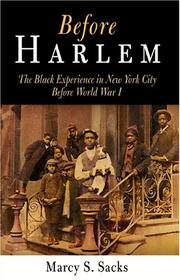| Listing 1 - 5 of 5 |
Sort by
|

ISBN: 081223961X 9780812239614 Year: 2006 Publisher: Philadelphia University of Pennsylvania press
Abstract | Keywords | Export | Availability | Bookmark
 Loading...
Loading...Choose an application
- Reference Manager
- EndNote
- RefWorks (Direct export to RefWorks)
African American neighborhoods --- African Americans --- City and town life --- Community life --- Inner cities --- History --- Economic conditions --- Social conditions --- New York (N.Y.) --- Race relations.

ISBN: 0812203356 081223961X Year: 2006 Publisher: University of Pennsylvania Press
Abstract | Keywords | Export | Availability | Bookmark
 Loading...
Loading...Choose an application
- Reference Manager
- EndNote
- RefWorks (Direct export to RefWorks)
In the years between 1880 and 1915, New York City and its environs underwent a tremendous demographic transformation with the arrival of millions of European immigrants, native whites from the rural countryside, and people of African descent from both the American South and the Caribbean. While all groups faced challenges in their adjustment to the city, hardening racial prejudices set the black experience apart from that of other newcomers. Through encounters with each other, blacks and whites, both together and in opposition, forged the contours of race relations that would affect the city for decades to come. Before Harlem reveals how black migrants and immigrants to New York entered a world far less welcoming than the one they had expected to find. White police officers, urban reformers, and neighbors faced off in a hostile environment that threatened black families in multiple ways. Unlike European immigrants, who typically struggled with low-paying jobs but who often saw their children move up the economic ladder, black people had limited employment opportunities that left them with almost no prospects of upward mobility. Their poverty and the vagaries of a restrictive job market forced unprecedented numbers of black women into the labor force, fundamentally affecting child-rearing practices and marital relationships. Despite hostile conditions, black people nevertheless claimed New York City as their own. Within their neighborhoods and their churches, their night clubs and their fraternal organizations, they forged discrete ethnic, regional, and religious communities. Diverse in their backgrounds, languages, and customs, black New Yorkers cultivated connections to others similar to themselves, forming organizations, support networks, and bonds of friendship with former strangers. In doing so, Marcy S. Sacks argues, they established a dynamic world that eventually sparked the Harlem Renaissance. By the 1920's, Harlem had become both a tragedy and a triumph-undeniably a ghetto replete with problems of poverty, overcrowding, and crime, but also a refuge and a haven, a physical place whose very name became legendary.
African Americans --- African American neighborhoods --- Inner cities --- Community life --- City and town life --- Social conditions --- Economic conditions. --- History. --- New York (N.Y.) --- History --- Race relations. --- African Studies. --- African-American Studies. --- American History. --- American Studies.
Book
ISBN: 9780812203356 Year: 2013 Publisher: Philadelphia
Abstract | Keywords | Export | Availability | Bookmark
 Loading...
Loading...Choose an application
- Reference Manager
- EndNote
- RefWorks (Direct export to RefWorks)

ISBN: 9780812203356 9780812239614 Year: 2013 Publisher: Philadelphia, Pa University of Pennsylvania Press
Abstract | Keywords | Export | Availability | Bookmark
 Loading...
Loading...Choose an application
- Reference Manager
- EndNote
- RefWorks (Direct export to RefWorks)
Book

ISBN: 1643150197 1643150200 Year: 2020 Publisher: Lever Press
Abstract | Keywords | Export | Availability | Bookmark
 Loading...
Loading...Choose an application
- Reference Manager
- EndNote
- RefWorks (Direct export to RefWorks)
"This co-authored collection offers valuable insights about the impact of leading off-campus study on faculty leaders' teaching, research, service, and overall well-being. Recognizing that faculty leaders are themselves global learners, the book addresses ways that liberal arts colleges can more effectively achieve their strategic goals for students' global learning by intentionally anticipating and supporting the needs of faculty leaders, as they grow and change. This volume offers key findings and recommendations to stimulate conversations among administrators, faculty, and staff about concrete actions they can explore and steps they can take on their campuses to both support faculty leaders of off-campus programs and advance strategic institutional goals for global learning. This collection includes transferrable pedagogical insights and the perspectives of faculty members who have led off-campus study programs in a variety of disciplines and geographic regions"--
Education, Humanistic. --- Education, Liberal --- Humanistic education --- Liberal arts education --- Liberal education --- Education --- Classical education --- Off-Campus Study
| Listing 1 - 5 of 5 |
Sort by
|

 Search
Search Feedback
Feedback About UniCat
About UniCat  Help
Help News
News